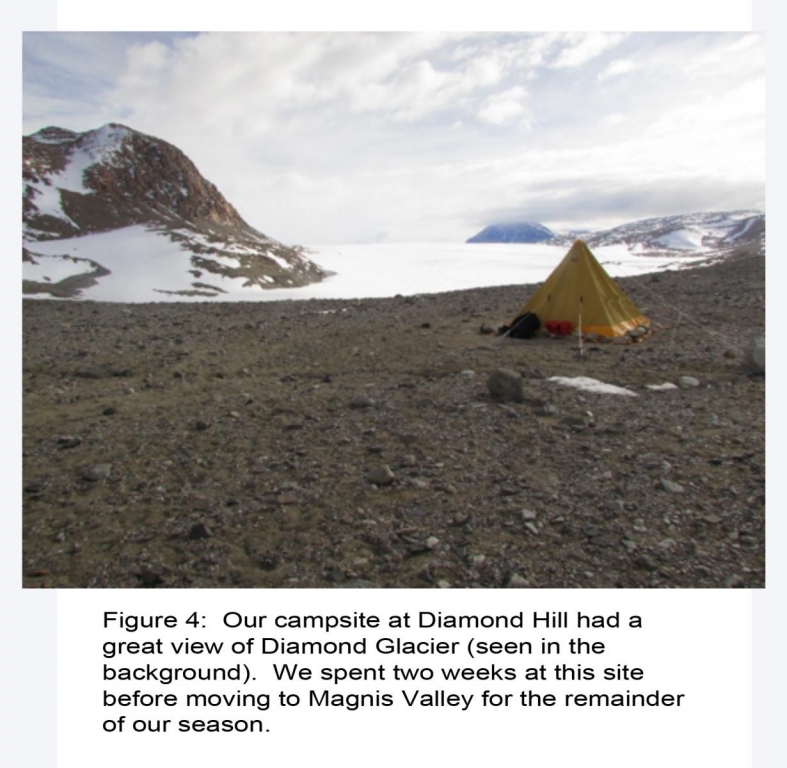Hatherton & Darwin Glacier, Antarctica 2014 – 2015
History of Grounded Ice in the Ross Embayment since the Last Glacial Maximum Using the Glacial Geology Alongside the Hatherton and Darwin Glacier system, Antarctica
Field Team Members: Courtney King1,2, Dr. Brenda Hall1,2, Trevor Hillebrand3, and Dr. John Stone31Climate Change Institute, University of Maine; 2Department of Earth and Climate Sciences, University of Maine; 3Earth and Space Sciences Department, University of Washington
Darwin and Hatherton Glaciers, Antarctica.
December 9, 2014 – January 12, 2015
Funding Support: National Science Foundation
Introduction
This year’s field expedition is a continuation of last year’s work along Hatherton Glacier. Our goal for this project is to determine the timing of the last glacial maximum (LGM) and subsequent recession for the Antarctic Ice Sheet (AIS). As mentioned in last year’s report, there is evidence that during the LGM, the AIS expanded to form grounded ice in the Ross Sea, leading to buttressing and thickening of the inflowing ice streams from West Antarctica and outlet glaciers from East Antarctica (Hall et al., 2013). Limited radiocarbon ages from alongside the Hatherton Darwin glacier system support the hypothesis for grounded ice in the Ross embayment during the LGM (Bockheim et al., 1989). In contrast, two recent publications presented surface exposure-ages from the Lake Wellman area and the region alongside upper Hatherton Glacier, in which authors postulate a much different history for grounded ice in the Ross embayment during the last glacial period (Joy et al., 2014; Storey et al., 2010). Storey et al. (2010) suggests that in the Lake Wellman region, there was little-to-no change in glacier extent, in contrast, the previous study by Bockheim et al. (1989) maps the LGM limit ~200 m above present position. In the region alongside upper Hatherton Glacier, Joy et al. (2014) concludes that due to the lack of surface exposure-age dates covering the LGM period, the ice extent during the last glacial period was likely lower than present. In order to test these hypotheses, we want to construct precise radiocarbon and surface exposure-age chronologies from numerous sites along the longitudinal profile of the Hatherton Darwin glacier system.
Field Work
Last year, we visited both the Lake Wellman area and the section of valleys alongside upper Hatherton Glacier, and for this year’s field season we chose a site located between those two, Magnis Valley. In addition, we went to Diamond Hill, located near the mouth of Darwin Glacier, a major outlet glacier that flows through the Transantarctic Mountains from East Antarctica (Figure 1). Dr. Hall and I collected fossil algae samples along transects perpendicular to the present ice margin that will be radiocarbon dated. Meanwhile, Dr. Stone and graduate student, Trevor Hillebrand, collected rock samples for surface exposure-age dating. Both dating methods will allow us to reconstruct a longitudinal profile of ice extent during the LGM, and track the subsequent ice recession.
Continuing Work
I began working on surficial geomorphic maps of the two field sites we visited last year, and this year I will also digitize the field maps of Magnis Valley and Diamond Hill using ArcGIS software. This will allow us to develop a longitudinal profile of the Hatherton Darwin glacier system ice extent for the LGM and subsequent recession. We sent more fossil algae samples to Woods Hole Oceanographic Institute for radiocarbon analysis, and the rock samples Dr. Stone and Trevor collected will undergo chemical analyses for beryllium isotopes at the University of Washington’s cosmogenic isotopes lab.
References
Bockheim, J.G., Wilson, S.C., Denton, G.H., Andersen, B.G., Stuiver, M., 1989. Late Quaternary ice-surface fluctuations of Hatherton Glacier, Transantarctic Mountains. Quat. Res. 31, 229–254. doi:10.1016/0033-5894(89)90007-0
Hall, B.L., Denton, G.H., Stone, J.O., Conway, H., 2013. History of the grounded ice sheet in the Ross Sea sector of Antarctica during the Last Glacial Maximum and the last termination. Geol. Soc. London, Spec. Publ. 381, 167–181. doi:10.1144/SP381.5
Joy, K., Fink, D., Storey, B., Atkins, C., 2014. A 2 million year glacial chronology of the Hatherton Glacier, Antarctica and implications for the size of the East Antarctic Ice Sheet at the last glacial maximum. Quat. Sci. Rev. 83, 46–57. doi:10.1016/j.quascirev.2013.10.028
Storey, B.C., Fink, D., Hood, D., Joy, K., Shulmeister, J., Riger-Kusk, M., Stevens, M.I., 2010. Cosmogenic nuclide exposure age constraints on the glacial history of the Lake Wellman area, Darwin Mountains, Antarctica. Antarct. Sci. 22, 603–618. doi:10.1017/S0954102010000799






